BPW-Japan held the first National Conference on EPD in April, 2014

  
|
The Japanese Equal Pay Day in 2014 was April 13, two days earlier than the last year's EPD, April 15. In Japan, women have to work more than four months longer to achieve the same amount of wages as men do in a year. BPW-Japan has been encouraging all clubs and affiliates to join this unique campaign to raise awareness about a wide wage gap between men and women nationwide. This year, a record number of 10 clubs participated in EPD campaign activities in many ways. In addition to annual campaigns on the streets and visits to governmental offices concerned, BPW-Japan first time held the National Conference on EPD on April 19, 2014 in Tokyo. Approximately 50 people gathered at the Fusen-Kaikan Hall, to participate the Conference. The aim of the Conference is to bring together experts, government officials, media, and BPW members/non-members, to learn and discuss about the wage gap between men and women. The Conference was supported by the Ministry of Health, Labour and Welfare (MHLW), and Gender Equality Bureau in the Cabinet Office. Ms Yuki Narita (Director of Equal Employment, Children and Families Bureau, MHLW) made an opening speech and a brief talk about the recent labor policy. A keynote speaker, Dr. Hiroki Sato (Professor at Tokyo University) gave a lecture how we can narrow the gender pay gap. The discussion session with participants and networking session followed. As an outcome of Conference, we made a pledge to make every effort to narrow the gender wage gap which is one of the widest among developed countries. We will continue to work together with national and local governments, business community, civil society, as well as media. The president of BPW-Japan visited the Director of Equal Employment, Children and Families Bureau (MHLW) and the Director of Gender Equality Bureau, and requested their continuous support to reduce the wage gap between men and women. "The National Conference provides the opportunities to reaffirm the importance of EPD activities in our country. We also could share what other clubs have been doing through the conference. I believe that lessons learned from the Conference will give a boost to our future EPD action," Ms. Haniwa Natori, President of BPW-Japan said. |

Japan's Equal Pay Day on April 15, 2013
The 2013 Equal Pay Day was April 15 in Japan. It was much later date of EPD, compared with many other countries'. However, it was slightly earlier than EPD of last year. BPW Japan first time implemented an Equal Pay Day campaign on April 16, last year. A few clubs, as the first step, made the visit to the related governmental offices to introduce the concept of EPD. This year, we expanded our EPD campaign activities, both in number and depth.
This year, increasing number of clubs joined the campaign. Not only the number of participating clubs, their activities to raise the awareness of gender wage gap also increased. For example, prior to the EPD of April 15, members of Club Wakayama asked the local Gender Equality Center for the collaboration with their EPD campaign. An “EPD appeal board” was set up in the Center, and people who agree to the aims of campaign put red ribbons on the board, and wear another red ribbon to their working places in order to promote the awareness of gender wage gap. Club members also visited the related offices of prefectural and city government, and explained the concept of EPD and ask for the support and cooperation to the EPD campaign. They also visited six local business groups and economic associations to ask for the creation of better working environment for women who want to continue to work throughout their childrearing period. Further, they visited seven media organizations. On the campaign day, some of media conducted interviews at the campaign site. Later, the President of Club and others appeared on a live radio and TV show.

from left: Visit to Vice Governor; EDP campaign in Wakayama city; Live radio show.
Other than Wakayama, 10 clubs hold the EPD related activities in some way.
The EPD was calculated based on the previous year’s survey data, Basic Survey on Wage Structure (the Minister of Labour, Health and Welfare). According to the latest data, the difference in wage between men and women in 2012 was 28.1%, a slight downward from the gap of 29.7% in 2011. For more details of EPD estimation, see below.
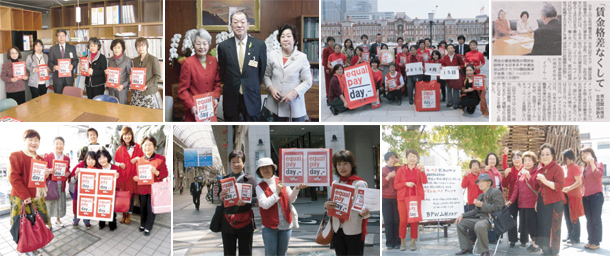
from upper left (clockwise): in Asahikawa City; in Yamagata City; With staff from MHLW in Tokyo; Kofu City in Yamanashi Yamagata News Paper; Marugame in Kagawa;.Kokura in Kitakyusyuu City;
BPW Japan finally launched its first Equal Pay Day campaign on April 16, 2012
BPW Club Tokyo held EPD campaign at the busiest business district, Marunouchi, taking EPD red gears to the street. Prior to the EPD, as a first step, President of BPW-Japan and other executives visited the Minister of Health, Labour and Welfare (MHLW) and Gender Equality Office on April 11. They introduced the concept of EPD and a wide range of EPD-related activities which BPW have been developing world-wide. They also asked for the support and cooperation for the EPD campaign in order to raise public awareness of the pay gap between men and women.
Several staff from the MHLW showed up Marunouchi on April 16, and distributed EPD clear plastic folders with us.
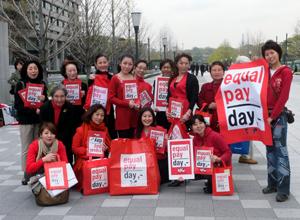
|
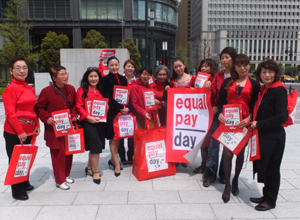
|
| Members of BPW Club Tokyo and their friends. (Marunouchi) | |
Members of Club Wakayama and Club Yamanashi marked the first EPD by visiting their Prefectural Governments (the labor office and gender equality office) on April 16. They introduced the concept of EPD and BPW’s EPD-related activities in European countries. These first-step activities were well received among local high-level officials and facilitated extensive discussions on the issue of equal pay. BPW members also handed a 70% of full size chocolate bar to officials. Club Yamagata and some other clubs are planning to do some EPD-related activities later.
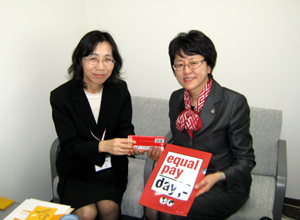
|
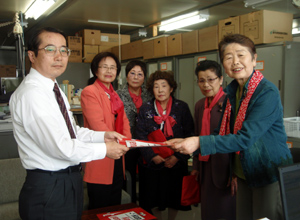
|
| President of BPW-Japn, Ms. Matsubara, handed a70% of full size chocolate bar to the Chief of Gender Equality Office of Wakayama Prefecture. | President of Club Yamanashi, Ms. Fukazawa, introduced the concept of EPD to the Chief of Equal Employment of Labour Department, Yamanashi Prefecture. |
Calculation of Japanese EPD
For the calculation of EPD of Japan, we first obtained the latest appropriate labor statistics from the Minister of Health, Labour and Welfare. Figures are male and female average wages of General Workers (which excludes Part-time Workers). They do not include overtime payment. The percentage wage difference between men and women we calculated for Japan was 29.4% in 2011. Then, we came up to the EPD of April 16, 2012, based on the 264 working days (22 days per month).
Both Yomiuri Shimbun and Nikkei Shimbun, two of leading Japanese papers, covered the EPD campaign which Club Tokyo held at the street.



